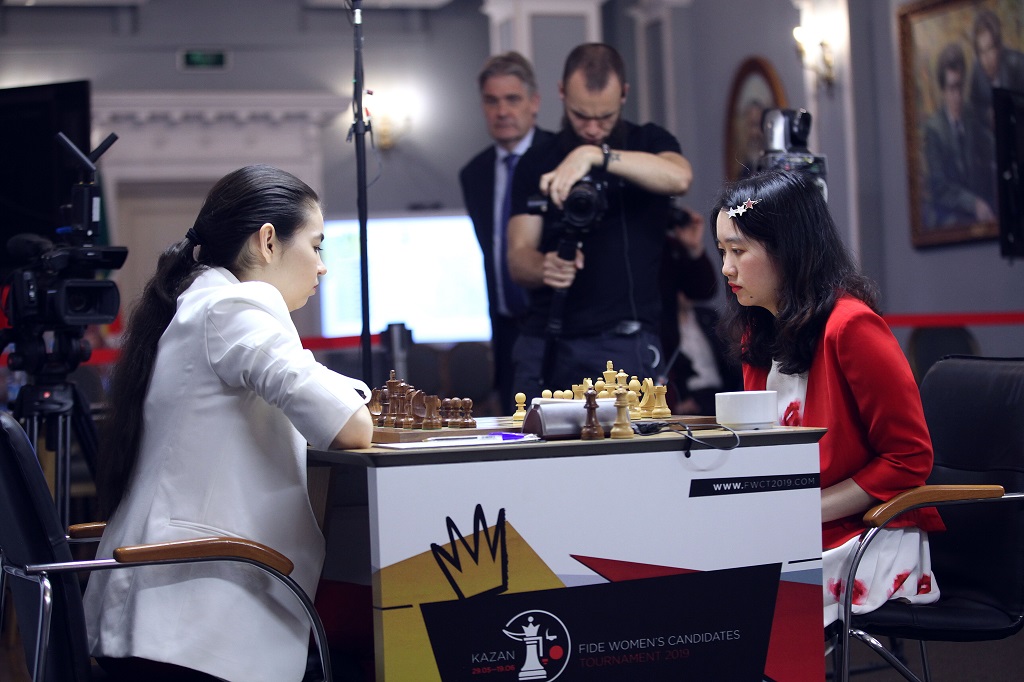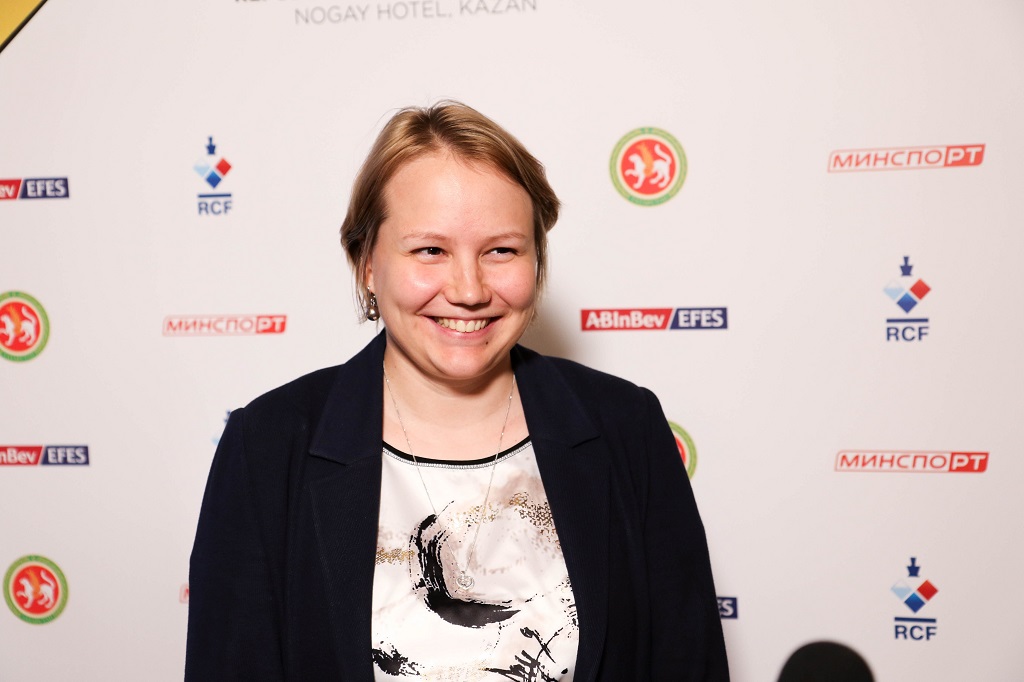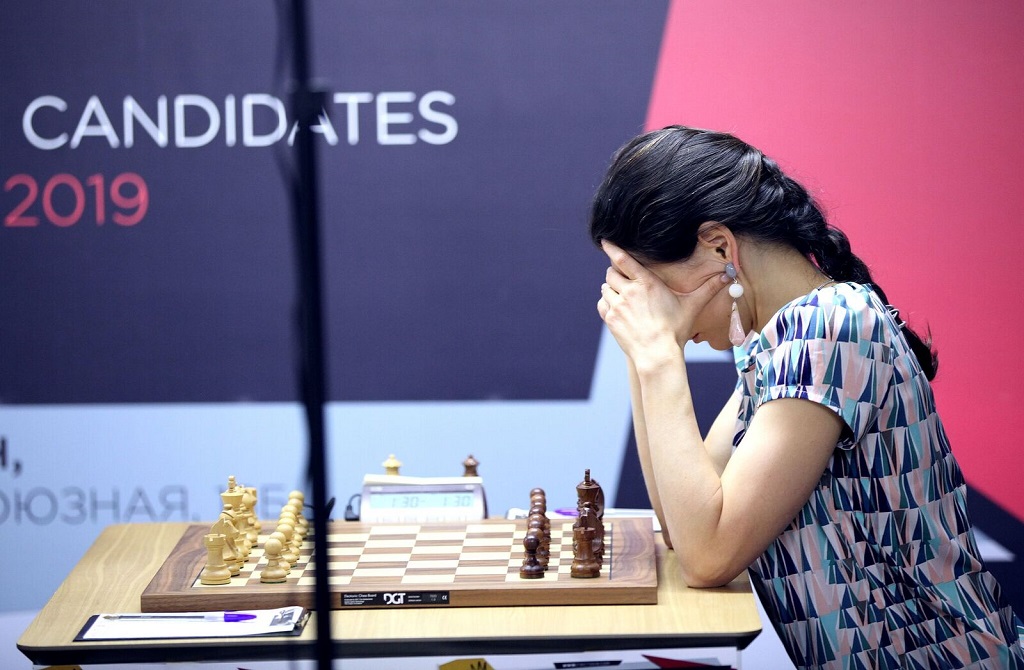


Getting such a clear-cut victory in a Candidates Tournament — with two rounds to spare — cannot but be regarded as a career-changing performance for a 20-year-old. Aleksandra Goryachkina will play her first World Championship match after having got her ticket with a commanding performance. While doing so, she also managed to climb to third place in the live ratings list, reducing the distance between her rating and that of Ju Wenjun from 55 to 22.4 points (for the time being).
The game that confirmed Aleksandra's first place finished drawn, but she could have easily kept on trying to get a win, as she was clearly on top in the final position. By then, however, Kateryna Lagno — who still had a mathematical chance to catch up with her — had lost against Anna Muzychuk, which meant the half point was enough to secure the title. Nana Dzagnidze and Valentina Gunina also won in round twelve.

Aleksandra Goryachkina will fight for the highest title in women's chess against Ju Wenjun | Photo: Eteri Kublashvili
For a third game with Black in a row, Goryachkina played the Caro-Kann Defence. A well-prepared Tan Zhongyi responded by blitzing out theory until move 16, when Aleksandra varied from a Giri v Navara game from last year. The Chinese grandmaster seemed more comfortable in the middlegame and slowly started putting pressure on Black's position. Tan Zhongyi could have left a scramble in the centre with a clear edge:
Aleksandra's 28...♞g6 gave White a chance to simplify into a superior position with 29.cxd5. White chose 29.♔g3 instead, preferring to prevent her rival from capturing the f-pawn — after 29.cxd5 ♞xf4 White had 30.d6, with an annoying passer on the d-file.
When the time control was reached, Tan Zhongyi was a pawn up and had the pair of bishops, but her king was more vulnerable. The Chinese could not make progress and the players started to shuffle their pieces around, looking for some entrance into the opposite camp. So much shuffling must have befuddled Tan, as she blundered on move 52:
White's 52.♔f2 in the previous move allowed 52...♛h1 and Black has a strong attack on the light squares. Goryachkina could have tried to make the most of her initiative, but decided to repeat moves with 53.♔e3 ♛e4+ 54.♔f2 ♛g2+ 53.♔e3 instead — an understandable decision if we take into account the tournament situation!

Tan Zhongyi missed her chances in the middlegame | Photo: Anastasiya Karlovich
Kateryna Lagno climbed to second place of the standings in round six and remained in that spot until her round twelve duel with Anna Muzychuk, who, after winning their direct encounter, is now in sole second place. The players started taking their time early in the game, as Lagno unexpectedly opted for 3...f5 after 1.e4 e5 2.♘f3 ♞c6 3.♗b5 (there are so many more lines of the Ruy Lopez to memorize!). Kateryna's intention to play a sharp game became even more clear when she went 7...h6 and 8...g5, but when it was time to keep playing actively she made a quiet move that gave her opponent a free hand on the kingside:
Black needed to play 18...b5, getting counterplay and preventing White from creating a battery on the b1-h7 diagonal (as was seen in the game) — Lagno played 18...♜ae8 instead and White coordinated her pieces on the light squares with 19.♕e4 ♞d8 20.♗d3.
White had a strong initiative, and eventually Black decided to give up an exchange to deal with the threats. Muzychuk kept her cool and did not falter in the conversion — Lagno resigned on move 45 in the following position:
White's rook will slowly but surely capture Black's pawns.

Anna Muzychuk and Kateryna Lagno swapped places in the standings table | Photo: Anastasiya Karlovich
After getting two consecutive wins in the longest games of each round (106 and 81 moves, respectively!), Valentina Gunina simply uttered in the post-game interview, "I feel completely dead". The 30-year-old Russian had been mentioning the fact that this tournament is too long for her in the previous rounds, but she has nonetheless bounced back from two straight losses in rounds nine and ten and is now on 5½/12.
Against former women's world champion Mariya Muzychuk, Gunina found herself in a rather uncomfortable position...until Mariya failed to play actively in a critical point of the game:
It is undeniable that White has the initiative, and here Muzychuk needed to bring one more piece to the party with 32.♖e3. The Ukrainian opted for 32.♗g3 instead, and found herself down an exchange in a queenless position after 32...b6 33.♖xc5 ♛xc5 34.♕xc5 bxc5.
White was a pawn up still, which made Gunina's task quite difficult. The Russian was up to the task, however, and got the win on move 81.

The ever smiling — even when tired — Valentina Gunina | Photo: Eteri Kublashvili
In the early middlegame, Nana Dzagnidze and Alexandra Kosteniuk delved into a strategical battle with most pieces still on the board. When both of them were fighting to get key squares and coordinate their pieces, Kosteniuk started going for rather mysterious manoeuvres:
Dzagnidze declared afterwards that she did not understand the point behind Black's 21...♜c6, which simply wasted a couple of tempi and gave White an opportunity to slowly improve her pieces.
A couple of moves later, Kosteniuk sacrificed a pawn in order to open up the centre with 26...d5, but could not prove there was compensation for Black in the battle that ensued. On move 31, Nana repositioned her knight to a strong central square:
Dzagnidze declared that she was expecting 31...♞de5 here, controlling the c4-square. Instead, Alexandra opted for 31...♜c2, allowing White's knight to get to d6 via c4 in the next two moves. From this point on, it was hard to imagine Black surviving against White's coordinated army. Resignation came on move 48.

Former women's world champion Alexandra Kosteniuk | Photo: Anastasiya Karlovich
Commentary provided by GM Evgeny Miroshnichenko and IM Elisabeth Paehtz